Rohingya refugees cross a makeshift bamboo bridge in Cox’s Bazar, Bangladesh, on May 2. (Photo: Reuters/Ro Yassin Abdumonab)
COX’S BAZAR, Bangladesh – Tens of thousands of visitors flock each week to this local seaside resort, a gateway to the world’s longest natural sea beach, named after a 19th century British colonial administrator.
In downtown Cox’s, as it is known, large, squat concrete hotels sit alongside garishly lit seafood restaurants and stores festooned with dried fish and gaudy souvenirs. From here, flat grey sand and straggling palm trees stretch for more than 120 kilometers along the southeast coast of Bangladesh, facing the Bay of Bengal.
The holidaymakers, mainly Bangladeshis, seem blithely unaware that around 30 km away is the world’s biggest refugee camp – hosting nearly 1 million Rohingya refugees from Myanmar in a space of 17 sq. km. The land, much of it uneven and prone to landslides, has become the core of a vast conurbation of bamboo and tarpaulin structures, officially known as the Kutupalong-Balukhali refugee camp.
The camp’s vulnerabilities are all too frequently highlighted by disasters such as fire, cyclones and storm damage.
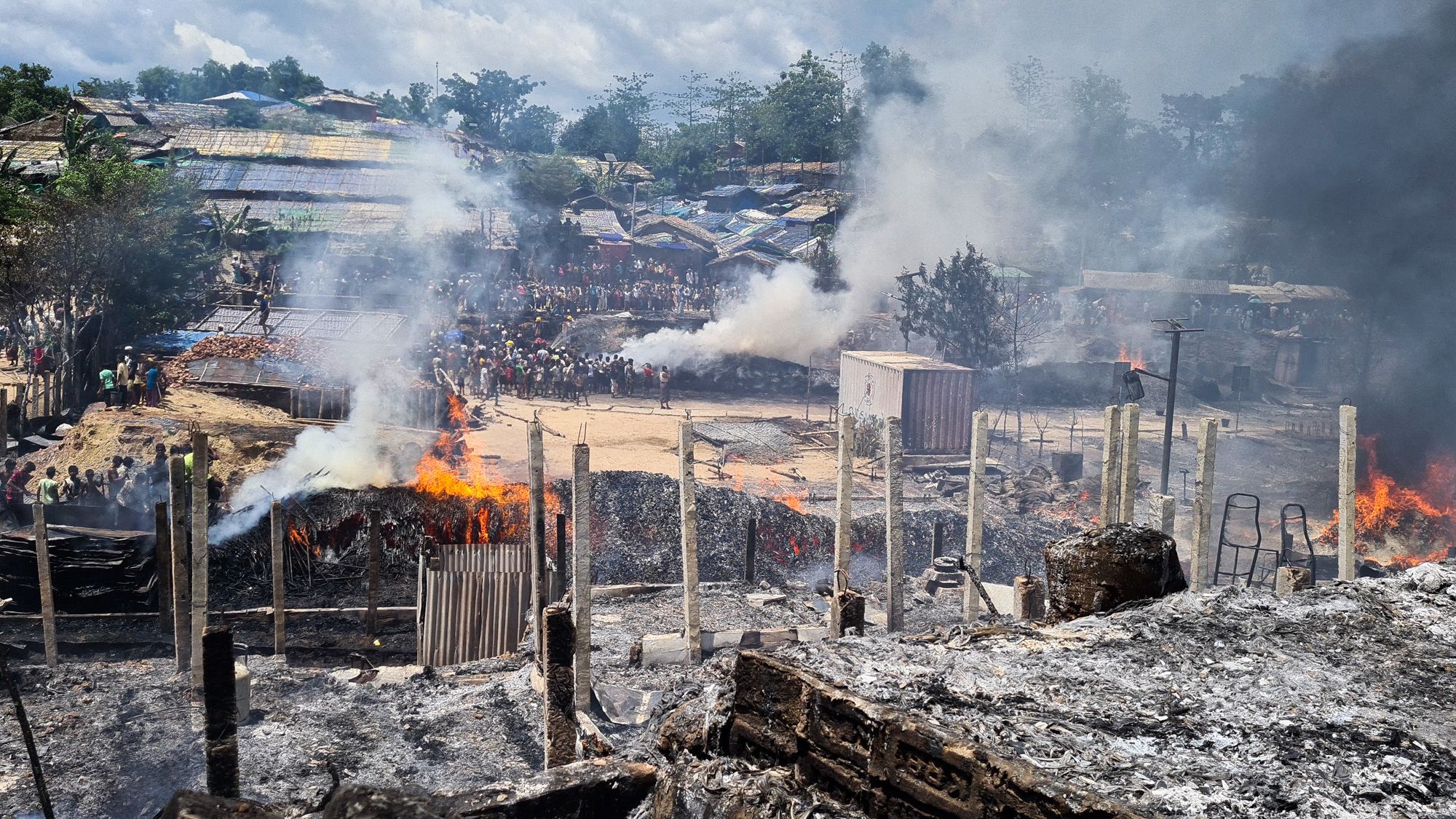
Many refugees’ dwellings were destroyed by a fire in a camp in Bangladesh’s Ukhiya district on May 24. (Photo: AFP)
Last week, a fire ripped through one of the camps, destroying over 400 dwellings and buildings and leaving an estimated 4,000 refugees homeless, while a cyclone that hit a few days later battered camps and surrounding villages with torrential rain and winds.
In 33 camps with an average population of 40,000, the refugees live in a staggering density of roughly 60,000 people per sq. km, according to United Nations agencies.
The 34th and newest camp shelters about 35,000 refugees on Bhasan Char, a low-lying island in the Bay of Bengal, 123 km away. Dhaka plans to relocate at least 65,000 more to the island in the coming year.
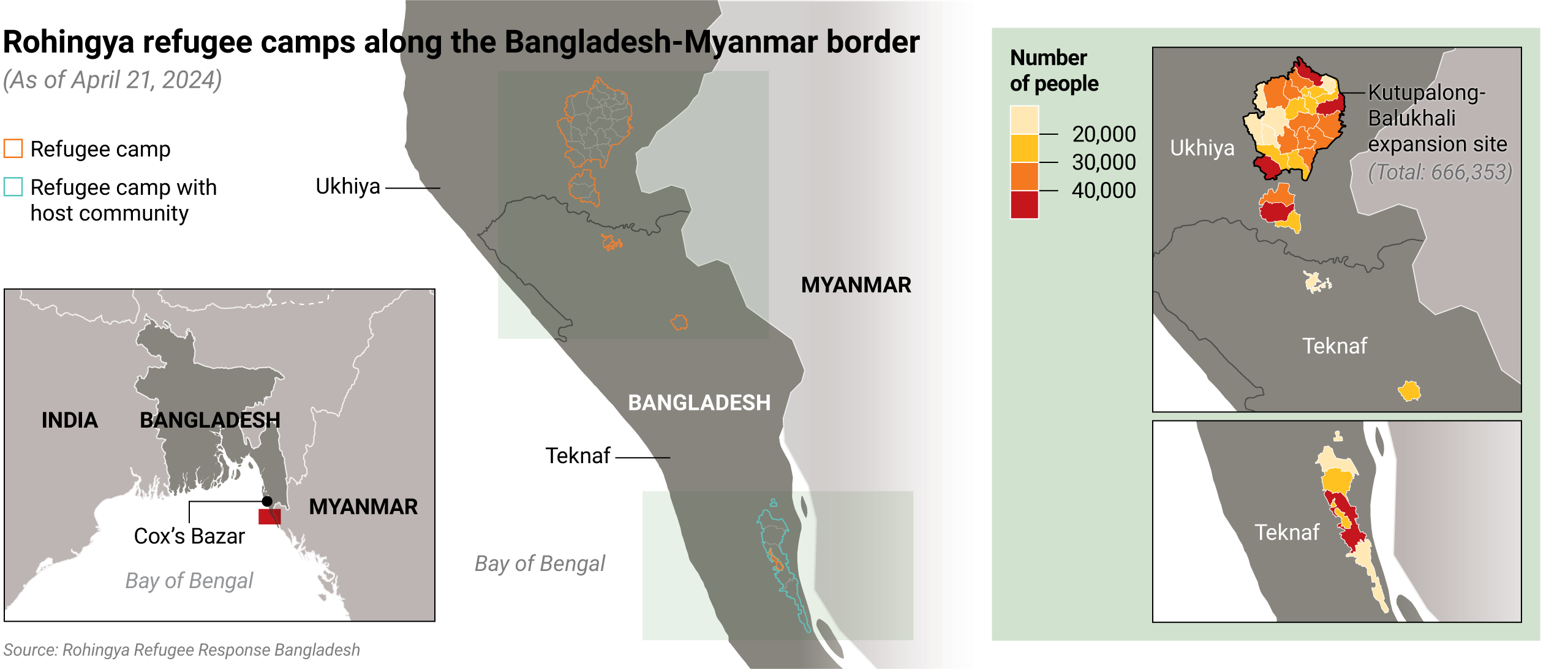
Most Rohingya refugees came to Bangladesh by foot and makeshift boats in August 2017, fleeing a savage campaign by Myanmar’s military that the U.S. has labeled a genocide.
Predominantly Muslim with cultural and linguistic traditions similar to those of Bangladesh, the Rohingya claim roots in Myanmar from the 7th century but have been regarded as interlopers and denied citizenship by successive Burmese governments.
Before 2017, they accounted for more than a third of the 3.3 million population of Myanmar’s western Rakhine state. Now they number fewer than 600,000, according to U.N. estimates. In Bangladesh, the refugees seem as far from repatriation as they were in 2017.
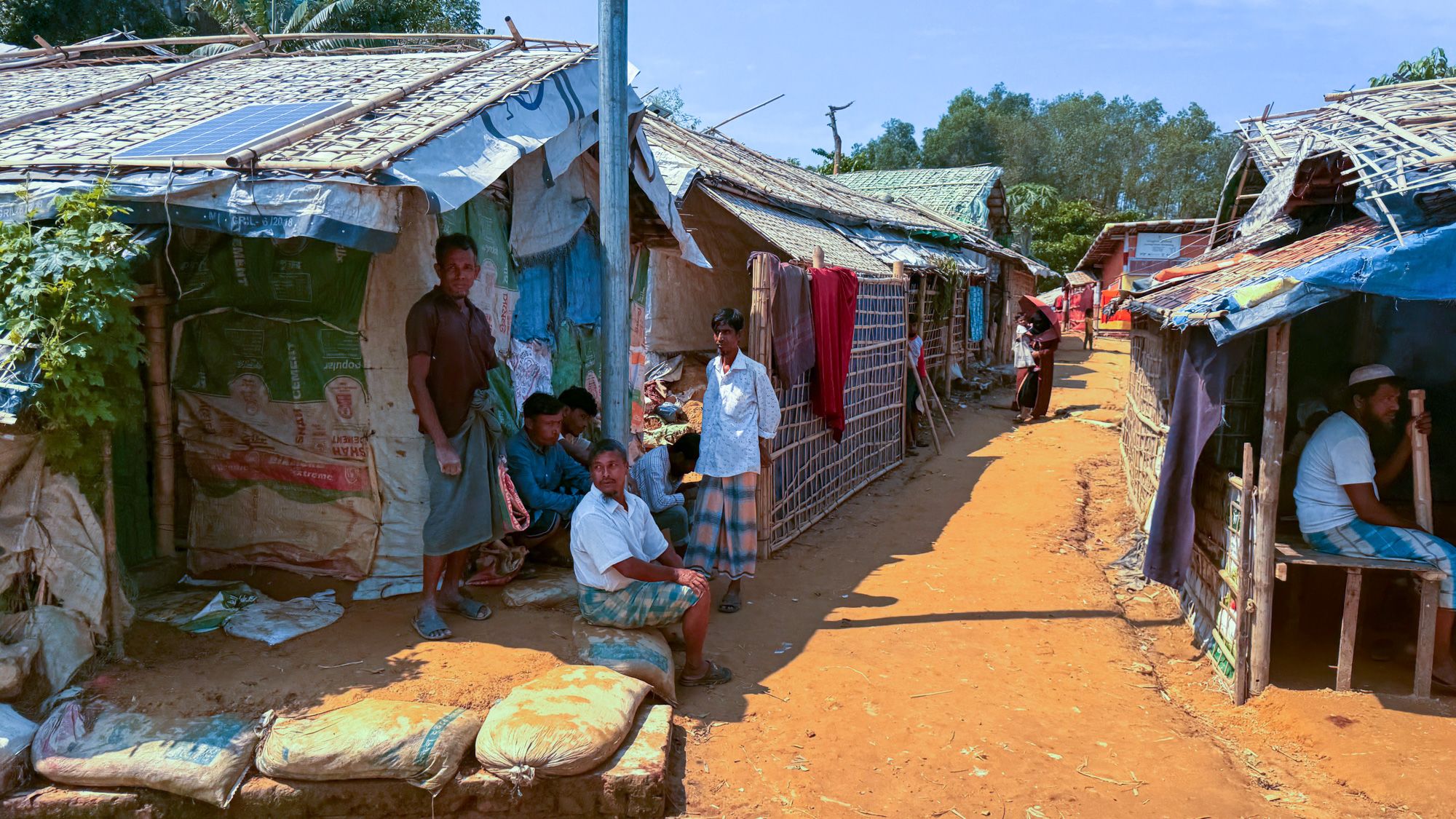
A typical lane in the Cox’s Bazar camps. Solar panels and small gas cooking stoves have helped improve refugees’ lives. (Photo: Gwen Robinson)
Caught between an intensifying civil war in Myanmar, geopolitical tensions among big powers and fruitless rounds of international talks on repatriation, the fate of the Rohingya remains a festering sore blighting any regional development vision. In Bangladesh, rising domestic criticism is further eroding Dhaka’s patience and reinforcing “compassion fatigue” among donors who are footing the costs of maintaining the camps.
“So why should the world care about Rohingya refugees?” asked a European diplomat in Dhaka. The same question dominates debate about Myanmar’s spiraling civil conflict, and the answer is similar: Without resolution of the Rohingya crisis, and Myanmar’s civil war, he explained, “regional instability can only escalate and weigh on this highly strategic part of the world.”
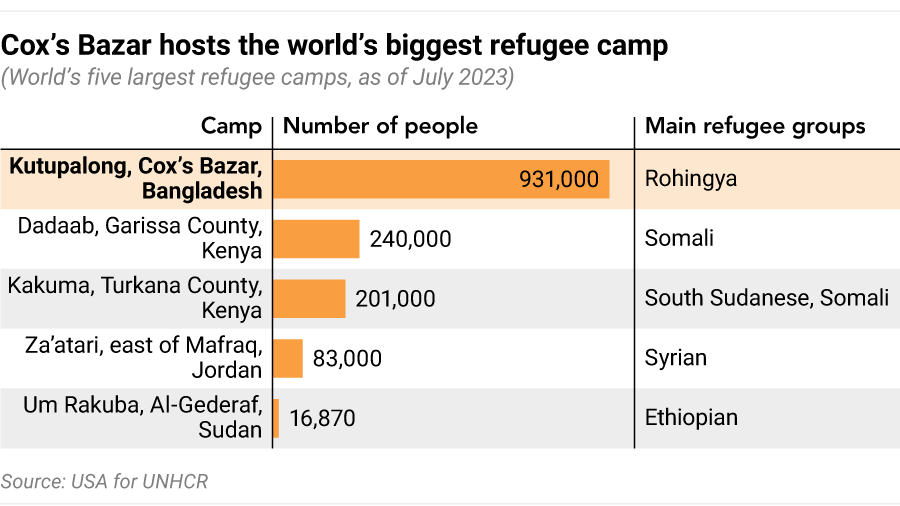
Worlds apart
The two worlds in Cox’s Bazar could not be more different, an incongruous juxtaposition of desperation and hedonism, with zealous local business interests leaping in to take advantage of both in property development, tourism services and lucrative business with the aid industry.
“Six years ago, this was little more than a dirt road and a forlorn collection of hotels,” an aid worker with an international nongovernmental organization told Nikkei Asia, gesturing from his beachside café seat toward the town’s main drag. “It used to take two hours for us to get to the camps each day. Now it takes 30 minutes, thanks to road improvements.” The place has “transformed” since 2017, he said.
“It may be the greatest irony but – it’s mostly the refugee factor,” he added.
Refugees search for their belongings in the rubble after a fire in the Balukhali camp burned many of their tightly packed houses to the ground in March 2021. (Photo: Suman Paul)
Living costs in Cox’s have also spiraled as the tourism industry has taken off and aid workers have flooded in. Another humanitarian worker said her rent had nearly tripled in six years. There is even a move to upgrade the airport from a domestic one to an international facility to bring visitors from abroad.
The gargantuan task of providing food, shelter, water and sanitation for the mini-metropolis is shouldered by about 120 aid organizations overseen by the Bangladesh government and U.N. agencies.
The U.S. alone has accounted for 40% of the roughly $4 billion in donations since 2017. Other major donors include the U.K., European Union, Japan, Australia and Canada.
But as the crisis dragged on, many aid programs in 2022 began facing deep cuts. The most visible was made by the U.N.’s World Food Programme, which oversees food and basic nutrition for the refugees.
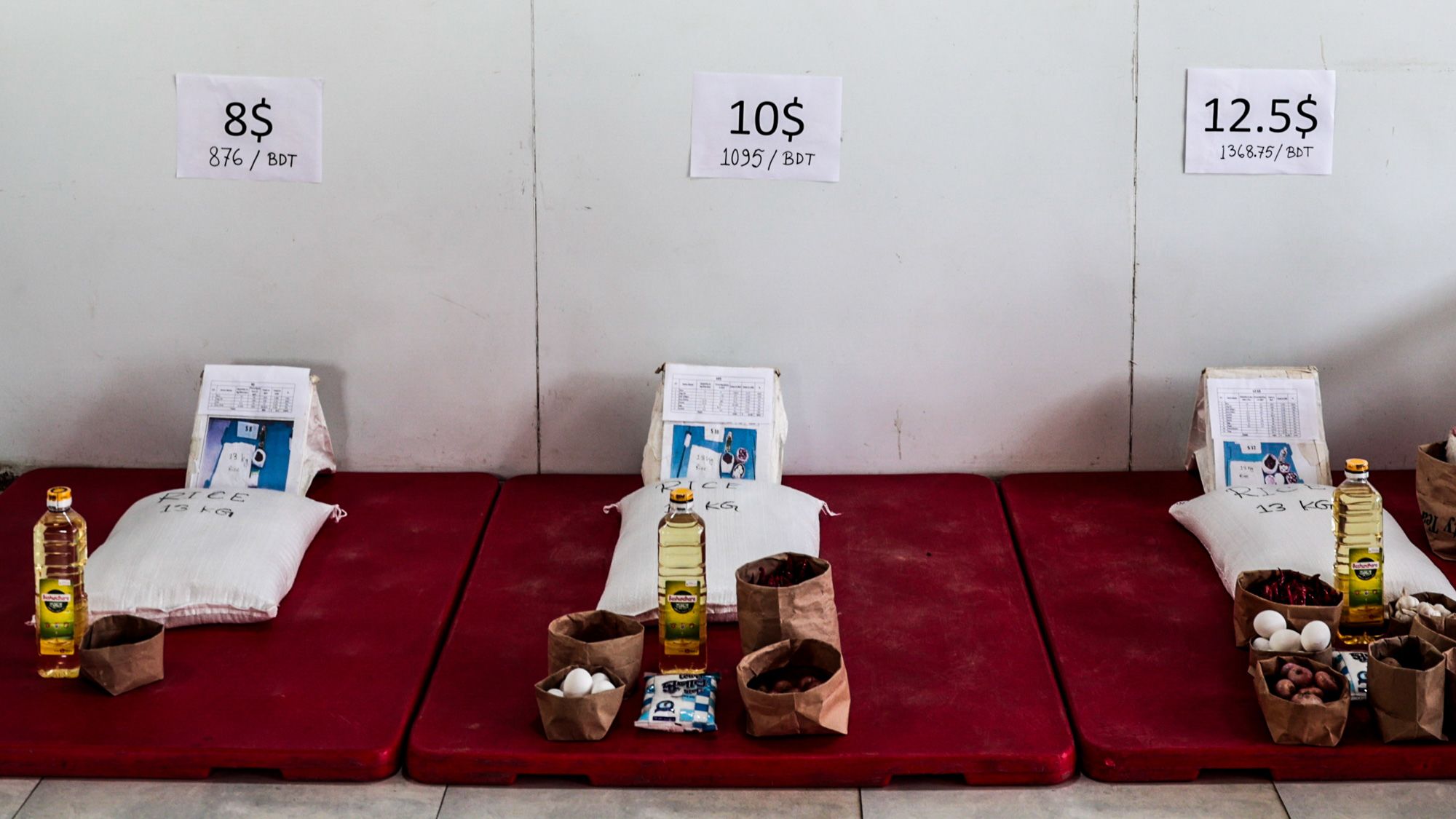
A representation of the monthly food rations distributed to each refugee in the Cox’s Bazar camps by the WFP. (Photo: USUN/Cristiano Minichiello)
The WFP last year slashed rations for camp residents from $12 per head to $10 per month and again to just $8, sparking warnings of malnutrition and unrest.
“[The ration cuts] made life much harder, we worried we couldn’t feed our children,” said Nur, a young refugee woman with four children, who spoke to Nikkei in her one-room dwelling.
The WFP has now clawed back some funding. Yet, other key agencies are suffering due to fresh crises in Gaza, Africa and Ukraine. Of this year’s annual budget request of $852 million for the Bangladesh-led multinational Rohingya Joint Response Plan, only 16% was funded as of mid-May.
Mounting dangers
A visit to the camps shows a striking disconnect between significant recent improvements – including remarkable reforms to education, food delivery systems, refugee rations and facilities – and the increasingly toxic backdrop of rising violence and illicit activity in the camps.
Temperatures hovered around 44 C in early May when a high-level U.S.-U.N. mission visited the sprawling settlement. For journalists, gaining Dhaka’s permission to access the camps is extremely difficult, but Nikkei Asia was among those able to accompany the mission, visiting refugee dwellings, camp facilities – including food centers and skills-training workshops – as well as reforestation projects, schools, farms and livelihood development schemes in local host communities.
Inside the labyrinthine network of tiny pathways and densely packed bamboo dwellings, refugees spoke about their lives.
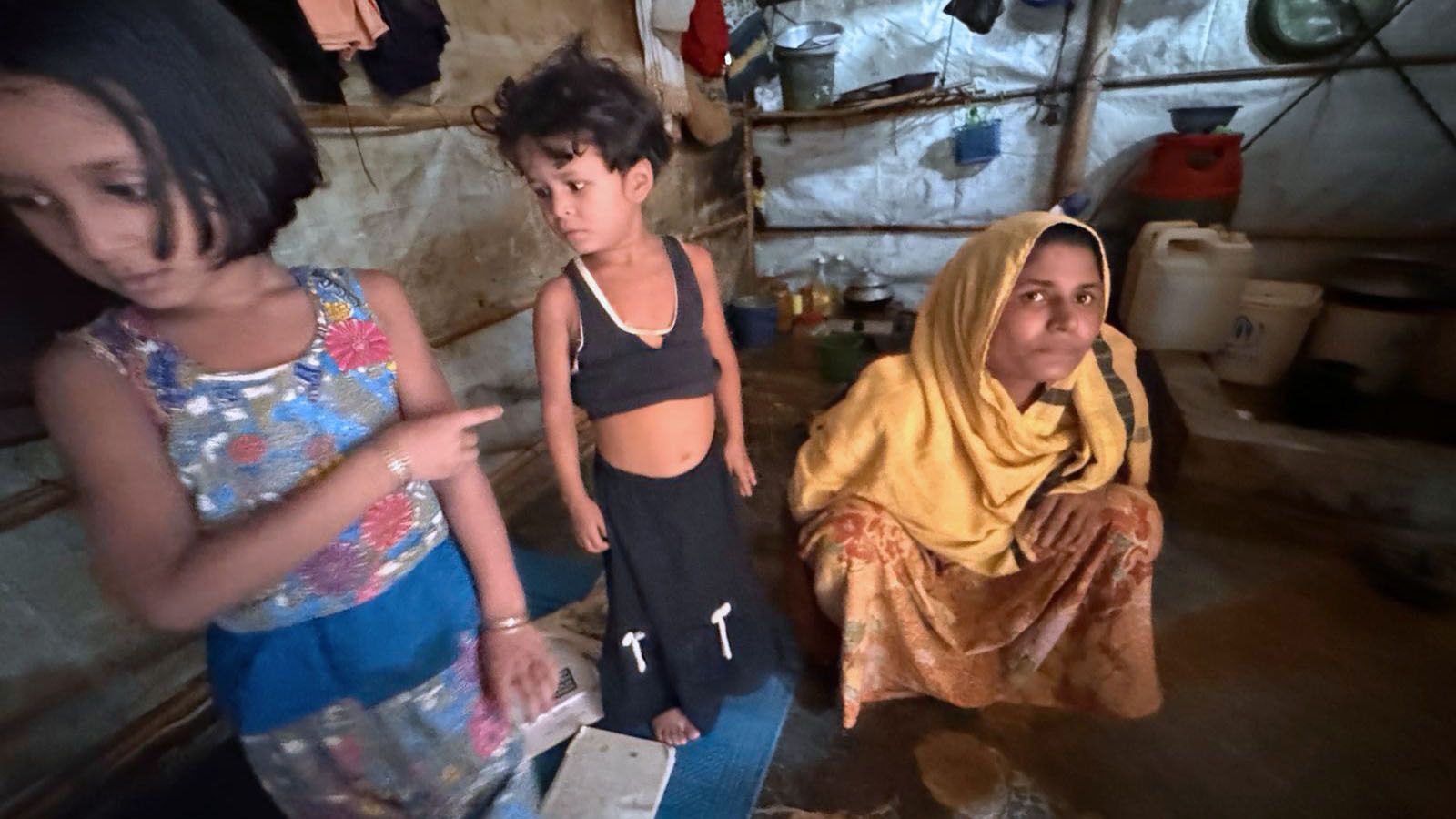
Kushida, far right, a 21-year-old refugee, says that gang violence and kidnapping are growing concerns in the camps. (Photo: Gwen Robinson)
“Now, there’s growing fear about kidnapping,” said Kushida, a young woman in Camp No. 4, clutching her infant child in a one-room hut. “Gangs kidnap people and demand money for their release … impossible amounts for people like us, like $2,000. They reduced, I heard, to $200, but even that is impossible, so then they kill people,” she whispered.
Despite her alarm, Kushida believes there is “no alternative” but to stay put. “We get food here, my daughter can go to school and my other child can start soon. But we cannot go out. My husband dare not go to the mosque.”
Like Kushida, all refugees interviewed voiced fears about deteriorating security. Most have raised their concerns with aid workers, they say, but to no avail. This year, there have been shootouts in daylight hours, one in April forcing U.N. staff to take shelter, and recent police raids uncovered arms caches including grenades and automatic weapons inside the camps.
“How can we feel safe?”
The camp police – only 2,000 for the equivalent of a city of 1 million people – are increasingly portrayed as part of the problem. “We try, but there are not enough of us,” a camp commander told Nikkei. But many refugees and aid workers say police tend to ignore or even participate in illicit activities. In early 2023, Human Rights Watch issued a report alleging “rampant police abuse of Rohingya refugees,” describing extortion, arbitrary arrests, and custodial torture of Rohingya refugees as well as collusion with criminal gangs in the camps.
While authorities deny the charges, no investigation has taken place. “Not all the police are bad. But everyone knows they are often part of the actual problem,” said a U.N. aid worker.
Deep inside another camp, Jaitun, a 24-year-old mother of two, sat on the packed-earth floor of her hut. Her husband has been in hiding for more than three months, sometimes furtively visiting their home by day but sleeping elsewhere at night. “He fears they will come and take him, either to kidnap or to fight,” she said, referring to local gangs.
“Of course, I think about returning [to Myanmar], but my village has been burned, there is torture and killing going on, how can we feel safe there?” She noted recent improvements to camp life, even as security has collapsed. “At least we can eat,” she said. “My children can go to the learning center. I never had education.”
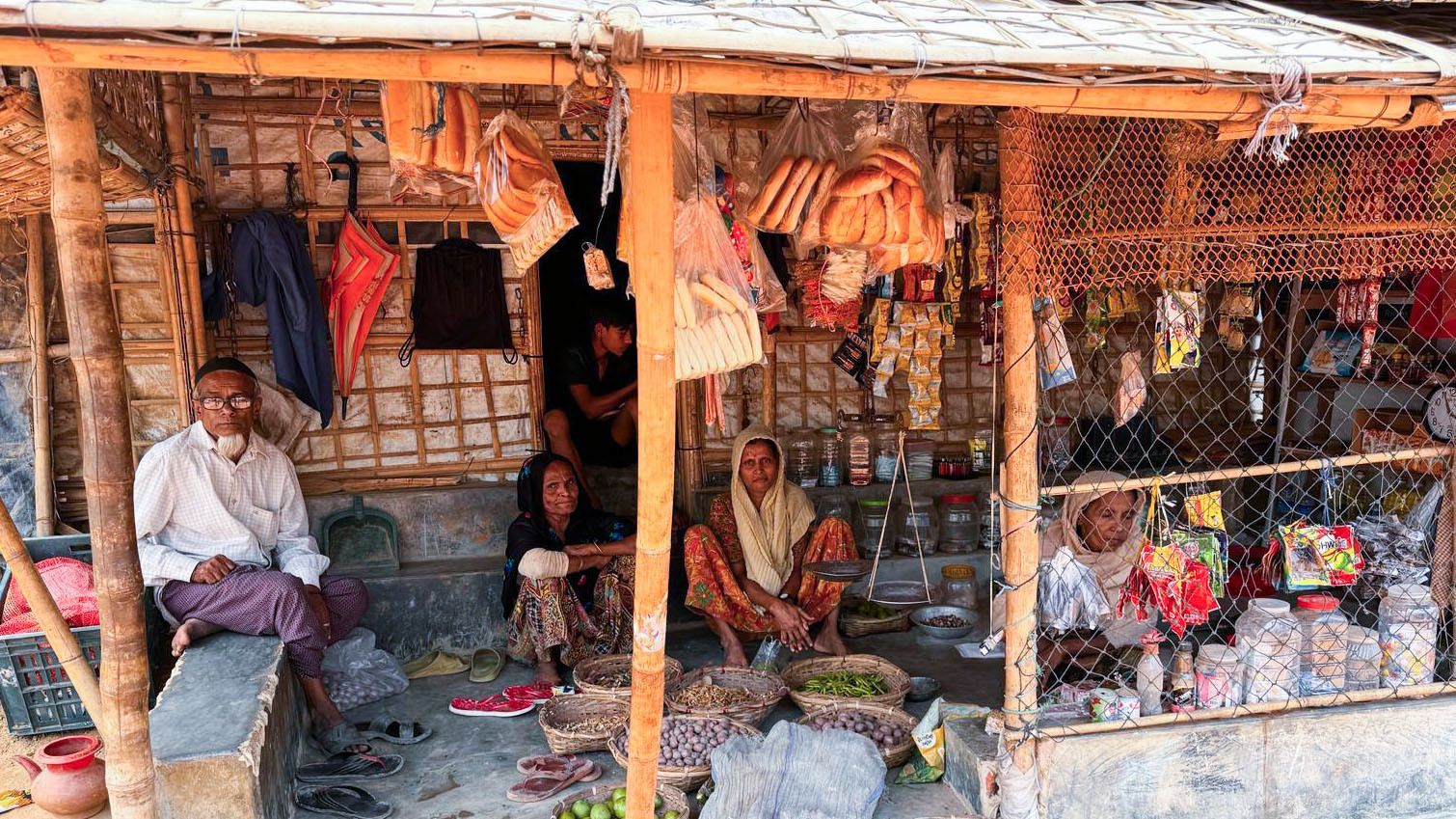
Two Rohingya families run a small shop selling snacks to fellow refugees inside a camp in Cox’s Bazar. (Photo: Gwen Robinson)
The shift from military to police security in the camps in late 2020 saw a marked increase in violence, drug trafficking and kidnapping as well as forced recruitment by militant groups. At the national level, rising criminality and violence in the camps are fueling a hardline, anti-Rohingya narrative among Bangladeshi critics that is driving a backlash against the refugee presence.
The former Bangladeshi foreign minister, A.K. Abdul Momen, now a member of parliament, recently described the Rohingya as “like a cancer” for Bangladesh, and amplified his push to send them back – despite mass internal displacement and intensifying conflict inside Myanmar. Normally outspoken Prime Minister Sheikh Hasina has avoided such incendiary statements – even expressing sympathy for the Rohingya plight. But she has also repeatedly voiced her government’s wish to send the refugees home.
In August 2017, Bangladesh earned international praise for opening its borders to the Rohingya refugees as persecuted Muslim brethren, with no restrictions on their entry. Dhaka’s minister for disaster management and relief at the time said they could seek shelter for “as long as they wanted.”
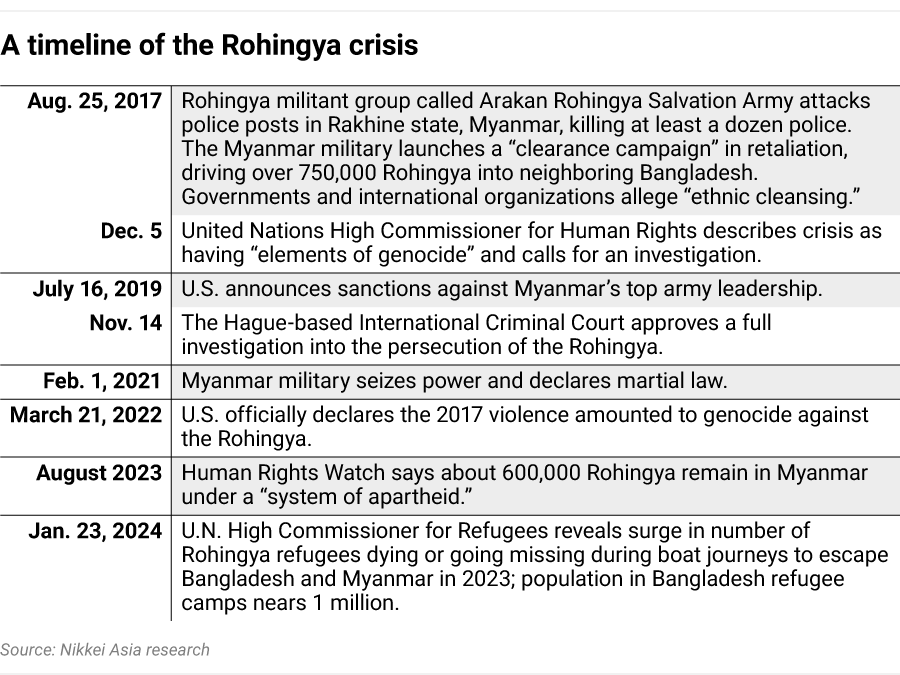
That tone has changed. Initially, the government allocated about 3,000 acres of public land for a makeshift camp at Kutupalong, a sparsely forested area that hosted a refugee influx in 1991, when Myanmar’s military drove out some 250,000 Rohingya in a smaller but equally brutal operation. That land, in Dhaka’s view, has reached its absolute limit.
Today, the Rohingya are among the world’s largest stateless populations and arguably the most persecuted. Successive Myanmar governments have refused to recognize their claims to citizenship despite evidence that many go back for generations in the country. The U.N. has repeatedly insisted that conditions are not conducive to “voluntary, safe and dignified returns,” even as Bangladesh and other countries, including China, have pressed to start the repatriation process.
Amid escalating violence inside Myanmar after the February 2021 coup, total displacement reached an estimated 3 million of the country’s 55 million people in April – quashing any notion of reviving the repatriation process. In Northern Rakhine, home to the majority of remaining Rohingya, the conflict now risks triggering a fresh exodus into Bangladesh, although Dhaka this time has warned it will push back any new refugees.
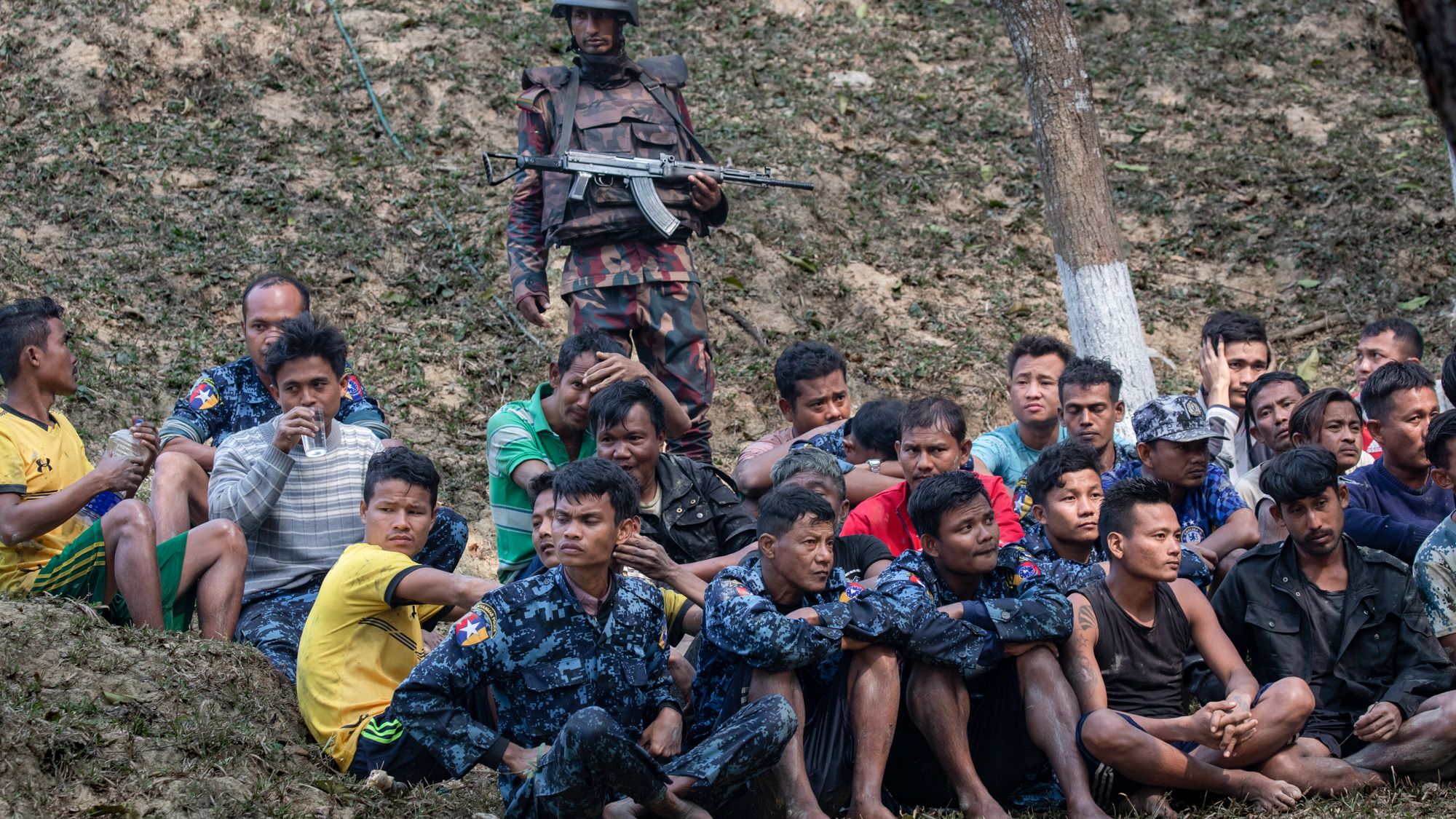
Myanmar border police take shelter inside Bangladesh to escape armed conflict on Feb. 7. (Photo: Getty Images)
Rohingya communities remaining in Myanmar have been caught in a ferocious conflict between the Arakan Army, led by ethnic Buddhist Rakhine, and the predominantly Buddhist Myanmar military. Further complicating the picture is the murky role of militant Rohingya groups. Recent testimonies and social media posts suggest all sides have been recruiting Rohingya youths, including from the camps in Bangladesh, using coercion, deception or even abduction, to serve with the military, the AA or militant groups.
Researchers who monitor the situation said evidence suggests that at least 2,000 men have crossed the border from the camps so far this year, either coerced or lured by militants.
Refugees gather in Cox’s Bazar to mark “Genocide Memorial Day” on Aug. 25, 2019, in remembrance of the Rohingya who perished in the Myanmar military’s campaign against them in 2017. (Photo: Abul Kalam)
Much of the recent illicit activity in the camps reflects the growth of militant Rohingya groups, including the revival of the Rohingya Solidarity Organization (RSO), founded in the 1980s in Myanmar to counter the Burmese military, and the Arakan Rohingya Salvation Army, formerly known as Harakah Al Yaqeen, which first appeared in 2017, among about 20 groups largely considered criminal gangs. Some espouse causes such as liberation of the “Rohingya homeland.” Others are focused on criminal activity, but all are “fighting for control of the camps,” according to a December report by International Crisis Group.
Aid workers rattle off the details of which group controls what camp. “ARSA used to control Camp No. 1 but now RSO does, which is why refugees were trying to attack RSO members,” explained one humanitarian worker.
The gangs’ brutal recruitment tactics triggered protests in late May. In one incident, Rohingya women armed only with broomsticks and tree branches tried to fight off gang members. One woman was later pictured bloodied and injured; her fate remains unclear. “The protests were astonishing, you rarely see Rohingya women involved in violent protests,” the camp worker said.
The rise of gang warfare alongside robbery, kidnapping, rapes and coerced recruitment has fed a fresh exodus from the camps, as refugees who can raise the funds to pay human traffickers try to flee in rickety boats.
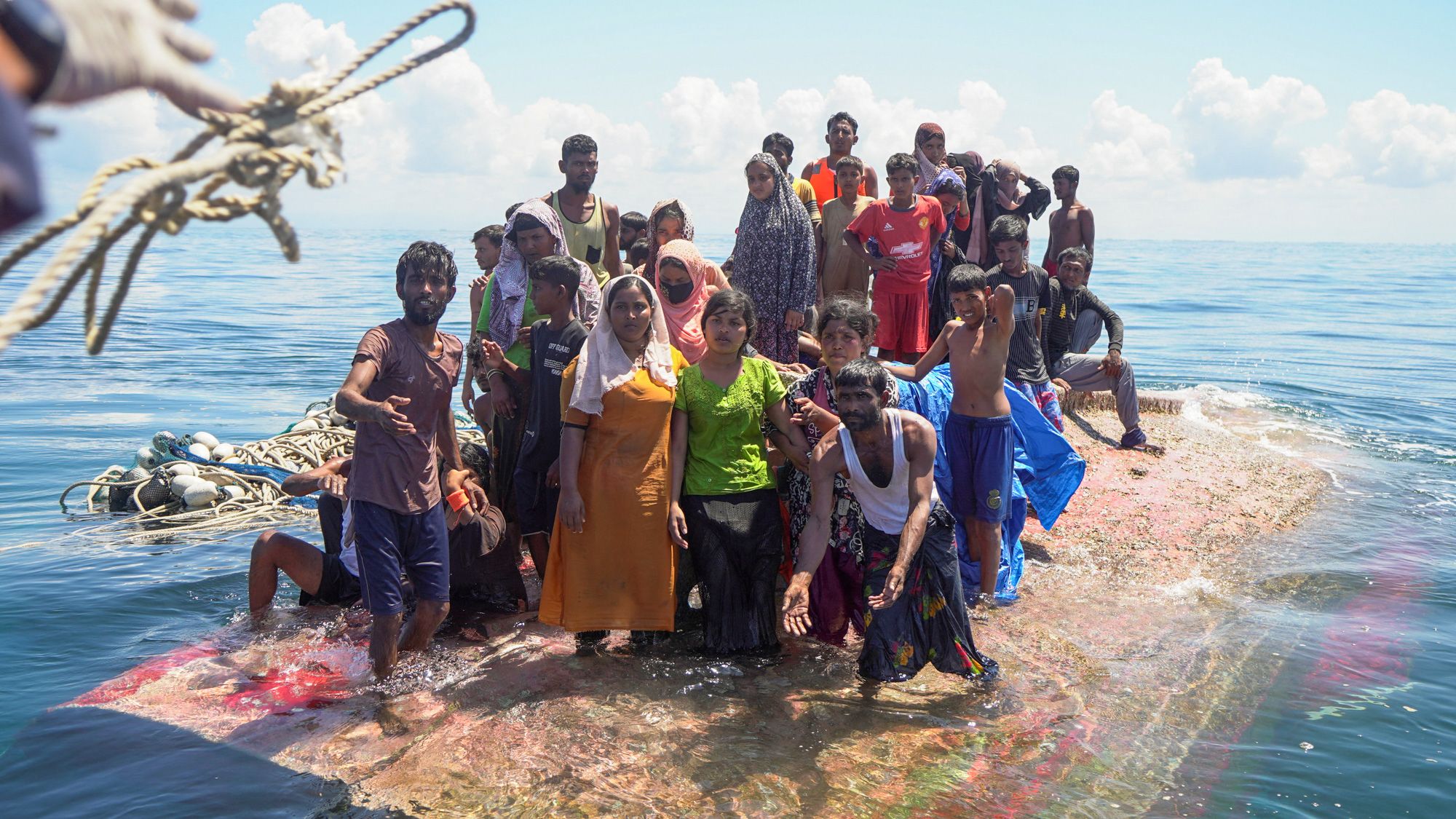
Rohingya refugees try to balance on a capsized boat in the waters off West Aceh, Indonesia, on March 21. (Photo: Reuters/Hendri)
Many pay the highest price, with their lives. In March, a boat crammed with Rohingya refugees from the camps capsized off Indonesia. While 75 people were rescued, more than 70 were missing and presumed dead. According to the U.N. High Commissioner for Refugees, nearly 4,500 Rohingya took boats across the Andaman Sea and Bay of Bengal in 2023 to escape camps in Bangladesh or persecution in Myanmar. About 570 died or went missing in the process, the highest number in a decade, the agency said.
The escalation of Myanmar’s civil war, and with it, the realization that repatriation is off the agenda for now, has galvanized the international community. In recent months, more international assistance has gone into the Bangladesh “host community” in Cox’s, including new infrastructure, assistance for local schools, support for local farmers and livelihood development.
In the camps, remarkable improvements have gone largely unnoticed, not least because of Dhaka’s reluctance to amplify any new signal of permanence or incentives for refugees to remain.
Quietly, the WFP has also been able to restore rations to $10 per head and from June will raise them to $11 per head, with plans to raise that to $12.50 in the coming months, according to U.N. officials. Households considered “most vulnerable” receive an extra $3 per month. From the dire predicament in 2023, the WFP is now fully funded through to 2025, officials said.
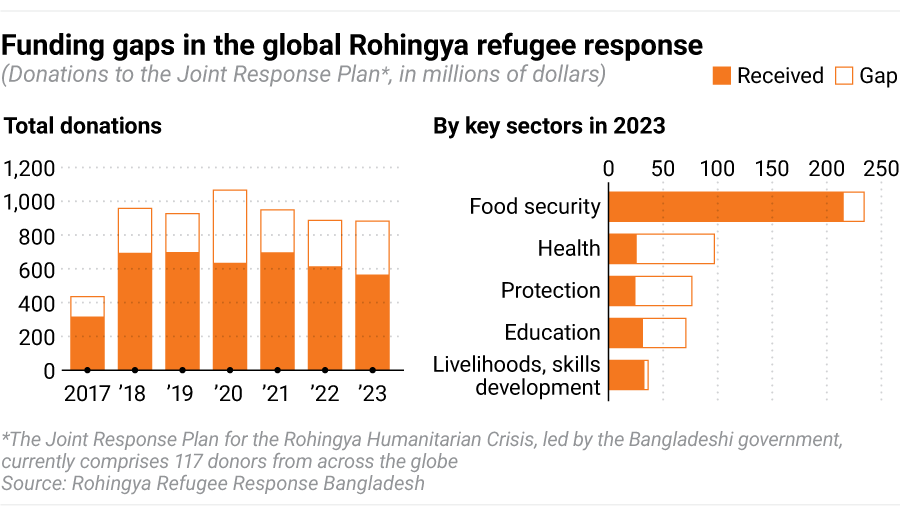
The U.S. has led the push to increase assistance. President Joe Biden last year reaffirmed a pledge to accept 125,000 refugees to America in 2024. “Welcoming refugees is part of who we are as Americans – our nation was founded by those fleeing religious persecution,” he said.
To spotlight the push for more refugee support, the U.S. recently appointed Jeffrey Prescott, a former senior Biden administration official, as U.S. representative to the United Nations Agencies for Food and Agriculture in Rome.
“The instability in Burma is only getting worse, and this response is going to go on for some time,” Prescott told Nikkei on his inaugural visit to the Rohingya camps in early May. “We’ve learned that when support goes down, the sense of insecurity goes up, there is more desperation. We need to galvanize more action around the world.”
Conversations in Cox’s Bazar with key aid officials highlighted the recent reforms to camp life, including improvements to food delivery systems.
The WFP is currently sourcing 5% of all fresh food for the camps from local communities, including vegetables, live chickens and other produce. In the context of the vast supplies required to feed 1 million people daily, this percentage is huge and has been a boon to Bangladeshi farming communities. “In my 33 years, this is the most innovative program I’ve seen,” said Dom Scalpelli, the WFP’s country director for Bangladesh.
Some local farmers employ Rohingya laborers – a common practice around Cox’s, which the Bangladesh government officially forbids.
“These Rohingya work well and they are cheap,” said Mozie, a village farmer. “Our young people don’t want to do this work anymore. Rohingya are hard workers – they work harder than us and have similar language and customs.”
But the most significant reform is the expansion of camp schooling. Starting this year, camp “learning centers” will be extended beyond Year 10 to the equivalent of Year 12, or around 18 years old according to agencies involved. There are also classes for those up to 24 who missed high school.
In another milestone, exams will be held for the first time in July, which will provide refugees a document to show they have completed their particular year. In a cramped hut that serves as a classroom, Instafa, aged 11 and one of 11 children, said she hoped to become a scientist. “School is the best part of life here, I just want to learn things,” she said.
There are other successful programs including “psycho-social” support for refugees. On a hilltop in Camp 18 sits the Rohingya Cultural Memory Center, a beautifully constructed bamboo building with airy spaces for displays of huge tapestries, wooden carvings of Rohingya boats, photographs and traditional arts and crafts. A project of the International Organization for Migration, the center documents Rohingya cultural heritage and conducts workshops for refugees.
Among finely wrought tapestries adorning the walls, the most striking is a colorful series by a dozen women that shows life in the camps, juxtaposed with life as they wish it to be and a third showing their earlier lives in Rakhine state.
Without portraying the violence and anxiety expressed by many refugees, “Camp Life” depicts refugees sitting in tiny houses, policemen and people collecting rations. The tapestries of past and future show green hills, streams, fields and smiling faces.
In another room, a Rohingya band plays haunting melodies on traditional instruments, singing about dreams of their homeland: “In nurturing our land, countless lives we’ve shed, May you not forget us, as our plea we spread.”
source : asia.nikkei
